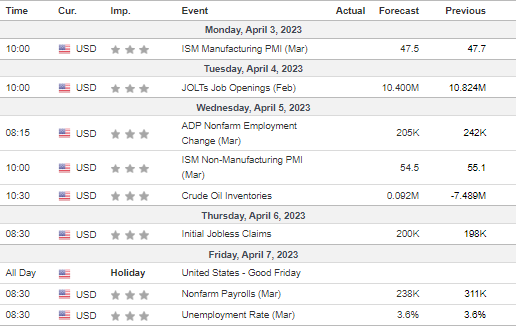A Look to the Week Ahead: What Bear Market?
Is the bear dead?

Markets closed out an incredible first quarter strong, with the S&P 500 gaining nearly 3.5% on the week, racking up over 7% in gains for the first quarter of 2023.
Moreover, the tech heavy Nasdaq entered a new bull market, jumping over 20% off its bear market lows in October.

One look at the charts shows you the strength of the most recent move, with the Nasdaq setting a second straight higher high and looking to be following a strong new uptrend.
If history is any indication, 2023 should be well positive, as no year has closed lower following a first quarter gain of 7% or more since 1900.
Despite worries revolving around the banking system and persistent inflation, bear have been steamrolled in the first quarter... but will this trend continue?
Most likely.
Despite large gains on major indexes, if we simply look at the S&P 485 (The S&P 500 without the top 15 largest companies), the index is actually down on the year.
This seems surprising, but really isn't.
Big names like Tesla, Nvidia and Apple are up tremendously over the last three months, justified or not, as investors poured into beaten down tech names to start the year.
As a result many larger indexes were carried higher, while the overall breadth of the market struggled to sustain gains. This doesn't bode well for the prospects of a new, healthy, bull market, as with earnings season right around the corner, many of these larger names are bound to pullback.
Softer earnings and overall compression is anticipated, and stocks trading at ridiculous multiples such as NVDA and its 150PE, will put pressure on stocks once again, and if the Fed stays firm in their 5%+ terminal rate for 2023, more pain is to come.
With this context in mind, lets take a look at the week ahead in economic data...
Economic Data
Week ending April 7, 2023

This week's main focus will be on a flurry of employment data releases as well as sporadic conferences from key Fed officials.
ISM PMIs are set to be released on both Monday and Wednesday, however markets have largely shifted away from giving these releases much weight as they have been relatively stable over the last few weeks.
Tuesday's JOLTs job openings will be key as there has finally been a material drop in job openings nationally, signifying that companies are finally pulling back on hiring, which bodes well for the weakening jobs market narrative that the Fed has been hunting for. Look for positive movement on further contraction of job openings.
Thursday is very quiet, with our usual weekly initial jobless claims being the only piece of data. This datapoint has become almost meaningless now as jobless claims have refused to shift off their seasonally adjusted 200k range for months now. Any surprise upwards print will be positive for markets.
Friday brings our biggest data of the week with the updated unemployment rate and Nonfarm Payrolls, which come relatively early in the month this time around. The stubborn labor market has refused to budge off record low unemployment levels, but increasing labor force participation, as indicated by last week's LFPR release, may finally loosen conditions in the labor market and help the unemployment rate shift higher, giving the Fed a sign that their rate hikes are working. However, nonfarm payrolls have stayed high for months, and businesses just keep adding more jobs every month, contradicting the idea that the labor market is truly weakening.


